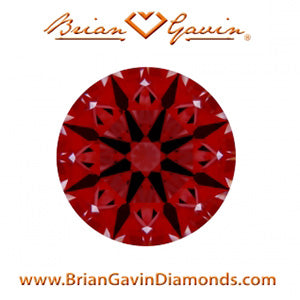
Unraveling the Mystery of Hearts and Arrows in Diamonds
“I saw a diamond at a department store that exhibits the Arrows pattern with the naked eye. Everything I’ve read about hearts and arrows diamonds online indicates that the arrows and hearts can only be seen with a special scope. I am not sure why they would say such a thing, because seeing is believing and I could clearly see the arrows pattern. I was however not able to see the hearts pattern. I also noticed that the arrows patterns seemed to be less apparent on other diamonds in their inventory. Can you help me untangle this mystery and shed some light on the subject?”
What makes the arrows pattern in round diamonds?
 The arrows pattern that is visible in round brilliant cut diamonds is created by light reflecting off the eight pavilion main facets located on the pavilion, which is the lower half of the diamond. Obviously it is possible to see the arrows pattern in the 1.341 carat, F-color, VS-1 clarity, Black by Brian Gavin diamond pictured above without a scope. However the arrows pattern is much more visible in the reflector scope image that appears to the left. Because the scope is designed to filter the light and highlight the pattern of hearts and arrows, it makes it much easier to distinguish the arrows pattern. This is actually an Ideal Scope image of this diamond.
The arrows pattern that is visible in round brilliant cut diamonds is created by light reflecting off the eight pavilion main facets located on the pavilion, which is the lower half of the diamond. Obviously it is possible to see the arrows pattern in the 1.341 carat, F-color, VS-1 clarity, Black by Brian Gavin diamond pictured above without a scope. However the arrows pattern is much more visible in the reflector scope image that appears to the left. Because the scope is designed to filter the light and highlight the pattern of hearts and arrows, it makes it much easier to distinguish the arrows pattern. This is actually an Ideal Scope image of this diamond.
The purpose of an ideal scope is to help us determine how much light a diamond is leaking as a result of the degree of optical precision. Diamonds of lesser cut quality might leak a substantial amount of light under the table facet. This Black by Brian Gavin diamond does not appear to be leaking any substantial light under the table facet, which is what these images are intended to demonstrate.
Note that the arrows pattern shows up dark in the clarity and reflector scope images, because the pavilion main facets are reflecting back the dark color of the camera lens. Under normal circumstances when you’re viewing the diamond, the arrows pattern is likely to appear translucent because the pavilion main facets are reflecting back the ceiling or the sky. However they may appear to be darker if the position of your head is obstructing the light that would otherwise reflect off of the facets.
Viewing hearts patterns in diamonds:
 It is absolutely necessary to use a special scope to view the hearts pattern in a diamond. The diamond also has to be unmounted, because the hearts pattern is only visible from the bottom. The handheld hearts and arrows scope uses red or blue colored filament paper to filter out the light that enters through the side of the scope, and a small white plastic disk that reflects white off of the facets of the diamond to highlight the pattern of hearts and arrows. It’s worthy of mention that the color red provides a more accurate assessment of the hearts and arrows pattern, while blue is more forgiving and seems to hide some imperfections in optical precision.
It is absolutely necessary to use a special scope to view the hearts pattern in a diamond. The diamond also has to be unmounted, because the hearts pattern is only visible from the bottom. The handheld hearts and arrows scope uses red or blue colored filament paper to filter out the light that enters through the side of the scope, and a small white plastic disk that reflects white off of the facets of the diamond to highlight the pattern of hearts and arrows. It’s worthy of mention that the color red provides a more accurate assessment of the hearts and arrows pattern, while blue is more forgiving and seems to hide some imperfections in optical precision.
Viewing arrows patterns in diamonds:
By now you know that the visibility of the arrows patterns in round brilliant cut diamonds is affected by the cut quality. However it is also affected by objects that might block light from reflecting off the pavilion mains, such as a camera lens or your head. Additional factors, such as contrast brilliance, will also be affected by the degree of optical precision and the proportions of the diamond.
Therefore while you might have been able to see the arrows pattern within the diamond you viewed in the department store, there is no way to actually determine whether the diamond is “Hearts and Arrows” without viewing the diamond while unmounted using a special scope.
Note that Brian Gavin Diamonds provides all of the images necessary to determine the cut quality of our diamonds on each diamond details page. We provide actual photographs of each diamond, whereas many vendors rely on computer generated renderings, or stock images to demonstrate hearts and arrows. Since the cut quality of each diamond is individual and unique due to the specific facet structure variations that vary from diamond to diamond, actual photographs are the only way to accurately judge the patterns.




















